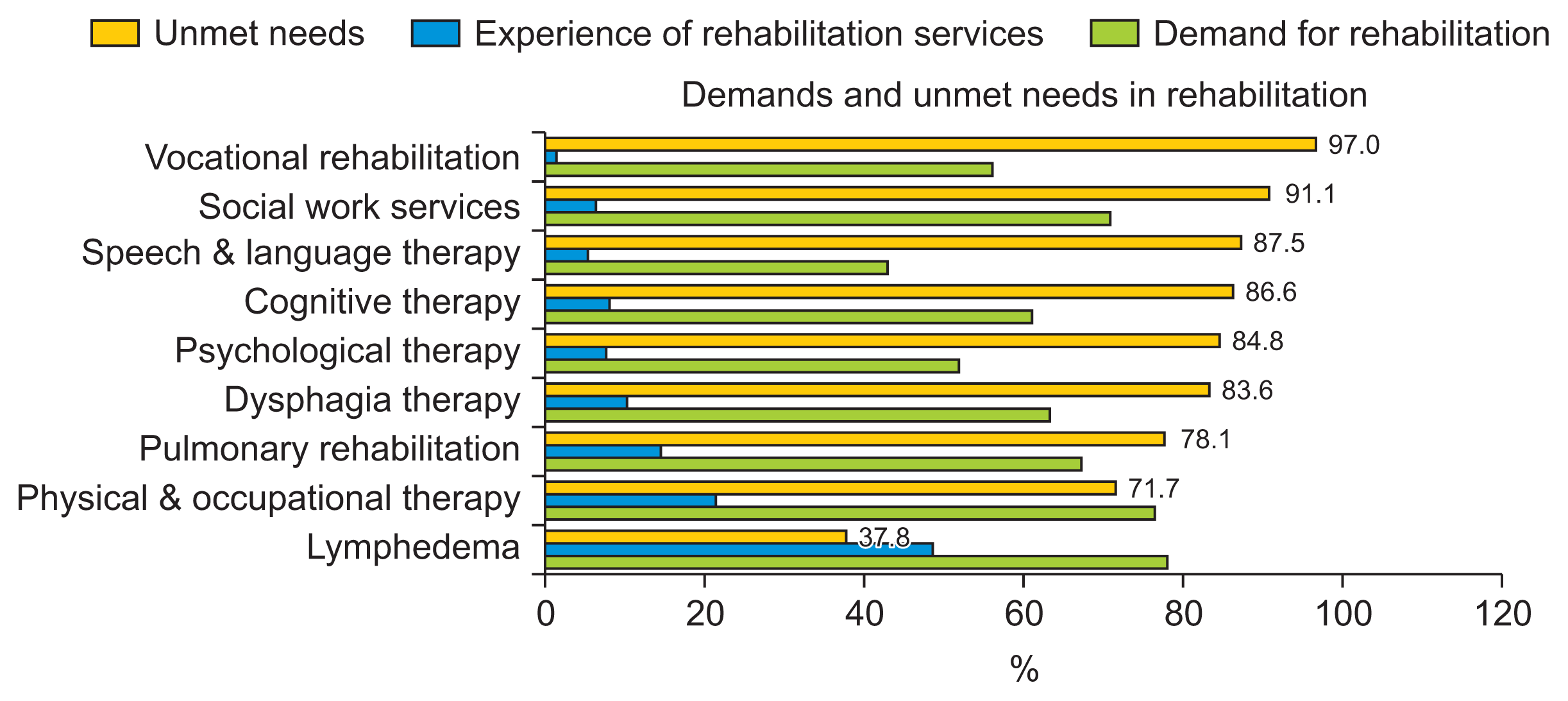1. Jung KW, Won YJ, Hong S, Kong HJ, Im JS, Seo HG. Prediction of cancer incidence and mortality in Korea, 2021. Cancer Res Treat. 2021; 53:316–22.

2. Kang MJ, Won YJ, Lee JJ, Jung KW, Kim HJ, Kong HJ, et al. Cancer statistics in Korea: incidence, mortality, survival, and prevalence in 2019. Cancer Res Treat. 2022; 54:330–44.

3. Movsas SB, Chang VT, Tunkel RS, Shah VV, Ryan LS, Millis SR. Rehabilitation needs of an inpatient medical oncology unit. Arch Phys Med Rehabil. 2003; 84:1642–6.
4. Cromes GF Jr. Implementation of interdisciplinary cancer rehabilitation. Rehabil Couns Bull. 1978; 21:230–7.
5. Jo JM, Hwang JH, Lee CH, Kang HJ, Yu JN. The need of cancer patients for rehabilitation services. J Korean Acad Rehabil Med. 2010; 34:691–700.
6. Hwang JH, Kim JS. Overview of cancer rehabilitation. J Korean Med Assoc. 2017; 60:678–84.

7. Silver JK, Baima J. Cancer prehabilitation: an opportunity to decrease treatment-related morbidity, increase cancer treatment options, and improve physical and psychological health outcomes. Am J Phys Med Rehabil. 2013; 92:715–27.
8. New PW, Townson A, Scivoletto G, Post MW, Eriks-Hoogland I, Gupta A, et al. International comparison of the organisation of rehabilitation services and systems of care for patients with spinal cord injury. Spinal Cord. 2013; 51:33–9.

9. Kim JY, Yi ES. Nationwide survey of cancer center programs in Korea. J Exerc Rehabil. 2017; 13:300–6.

10. Yang EJ, Chung SH, Jeon JY, Seo KS, Shin HI, Hwang JH, et al. Current practice and barriers in cancer rehabilitation: perspectives of Korean physiatrists. Cancer Res Treat. 2015; 47:370–8.

11. National Cancer Information Center. Cancer statistics [Internet]. Goyang, Korea: National Cancer Information Center;2020. [cited 2022 Aug 5]. Available from:
https://www.cancer.go.kr/
.
12. Mayer RS, Engle J. Rehabilitation of individuals with cancer. Ann Rehabil Med. 2022; 46:60–70.

13. Thorsen L, Gjerset GM, Loge JH, Kiserud CE, Skovlund E, Flotten T, et al. Cancer patients’ needs for rehabilitation services. Acta Oncol. 2011; 50:212–22.

14. Cheville AL, Beck LA, Petersen TL, Marks RS, Gamble GL. The detection and treatment of cancer-related functional problems in an outpatient setting. Support Care Cancer. 2009; 17:61–7.

15. Bower JE. Cancer-related fatigue: mechanisms, risk factors, and treatments. Nat Rev Clin Oncol. 2014; 11:597–609.

16. Berger AM, Mooney K, Alvarez-Perez A, Breitbart WS, Carpenter KM, Cella D, et al. Cancer-related fatigue, version 2.2015. J Natl Compr Canc Netw. 2015; 13:1012–39.

17. Mortimer JE, Barsevick AM, Bennett CL, Berger AM, Cleeland C, DeVader SR, et al. Studying cancer-related fatigue: report of the NCCN Scientific Research Committee. J Natl Compr Canc Netw. 2010; 8:1331–9.

18. Mustian KM, Alfano CM, Heckler C, Kleckner AS, Kleckner IR, Leach CR, et al. Comparison of pharmaceutical, psychological, and exercise treatments for cancer-related fatigue: a meta-analysis. JAMA Oncol. 2017; 3:961–8.

19. Mitchell SA, Hoffman AJ, Clark JC, DeGennaro RM, Poirier P, Robinson CB, et al. Putting evidence into practice: an update of evidence-based interventions for cancer-related fatigue during and following treatment. Clin J Oncol Nurs. 2014; 18:Suppl. 38–58.

20. Mitchell SA. Cancer-related fatigue: state of the science. PM R. 2010; 2:364–83.

21. Schmitz KH, Courneya KS, Matthews C, Demark-Wahnefried W, Galvao DA, Pinto BM, et al. American College of Sports Medicine roundtable on exercise guidelines for cancer survivors. Med Sci Sports Exerc. 2010; 42:1409–26.

22. Runowicz CD, Leach CR, Henry NL, Henry KS, Mackey HT, Cowens-Alvarado RL, et al. American Cancer Society/American Society of Clinical Oncology breast cancer survivorship care guideline. CA Cancer J Clin. 2016; 66:43–73.

23. Rockson SG. Lymphedema. Am J Med. 2001; 110:288–95.

24. Kim M, Park IH, Lee KS, Ro J, Jung SY, Lee S, et al. Breast cancer-related lymphedema after neoadjuvant chemotherapy. Cancer Res Treat. 2015; 47:416–23.

25. Yang EJ, Ahn S, Kim EK, Kang E, Park Y, Lim JY, et al. Use of a prospective surveillance model to prevent breast cancer treatment-related lymphedema: a single-center experience. Breast Cancer Res Treat. 2016; 160:269–76.

26. Korean Society of Lymphedema. Clinical guideline for secondary lymphedema. Seoul, Korea: Korean Society of Lymphedema;2015.
27. Stubblefield MD. Clinical evaluation and management of radiation fibrosis syndrome. Phys Med Rehabil Clin N Am. 2017; 28:89–100.

28. Staff NP, Grisold A, Grisold W, Windebank AJ. Chemotherapy-induced peripheral neuropathy: a current review. Ann Neurol. 2017; 81:772–81.

29. Hershman DL, Lacchetti C, Dworkin RH, Lavoie Smith EM, Bleeker J, Cavaletti G, et al. Prevention and management of chemotherapy-induced peripheral neuropathy in survivors of adult cancers: American Society of Clinical Oncology clinical practice guideline. J Clin Oncol. 2014; 32:1941–67.

30. Roberts KE, Rickett K, Feng S, Vagenas D, Woodward NE. Exercise therapies for preventing or treating aromatase inhibitor-induced musculoskeletal symptoms in early breast cancer. Cochrane Database Syst Rev. 2020; 1:CD012988.

31. Paulo TR, Rossi FE, Viezel J, Tosello GT, Seidinger SC, Simoes RR, et al. The impact of an exercise program on quality of life in older breast cancer survivors undergoing aromatase inhibitor therapy: a randomized controlled trial. Health Qual Life Outcomes. 2019; 17:17.

32. Gentry AL, Erickson KI, Sereika SM, Casillo FE, Crisafio ME, Donahue PT, et al. Protocol for Exercise Program in Cancer and Cognition (EPICC): a randomized controlled trial of the effects of aerobic exercise on cognitive function in postmenopausal women with breast cancer receiving aromatase inhibitor therapy. Contemp Clin Trials. 2018; 67:109–15.

33. Nyrop KA, Callahan LF, Cleveland RJ, Arbeeva LL, Hackney BS, Muss HB. Randomized controlled trial of a home-based walking program to reduce moderate to severe aromatase inhibitor-associated arthralgia in breast cancer survivors. Oncologist. 2017; 22:1238–49.






 PDF
PDF Citation
Citation Print
Print



 XML Download
XML Download